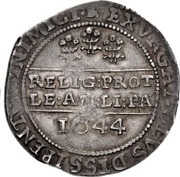
 The 1644 Halfcrown - Charles I
The 1644 Halfcrown - Charles IBristol Mint, dated 1644. Silver, diameter 35mm, weight 14.89g.
The Reverse shows the declaration with three Bristol plumes above and date below.
 The Obverse shows King Charles on horseback left, holding reins and raised sword; plumes to right.
The Obverse shows King Charles on horseback left, holding reins and raised sword; plumes to right.Coin shown condition good VF.
Images used by permission of CNG.
Mintage: Not known
Minted at The Royal Mint
More information (monarch, year, mint, country, category) can be found below coin listings.
Below are some coins currently being offered on eBay. As an eBay Partner, We may be compensated if you make a purchase.
List items on:
List items on:
Remember 1644 ?
Monarch is King Charles I. It's the time of the First English Civil War and the Royalists and Oliver Cromwell's army battle most of the year. In the Battle of Marston Moor, the largest battle of the English Civil War, it is a massive victory for the Parliamentary side, ending Charles I's hold on the north of England.
Charles I (1625-1649)
 Charles I was born on 19 November 1600 and was King of England, King of Scotland, and King of Ireland from 27 March 1625 until his execution on 30 January 1649. He was in the House of Stuart.
Charles I was born on 19 November 1600 and was King of England, King of Scotland, and King of Ireland from 27 March 1625 until his execution on 30 January 1649. He was in the House of Stuart.From 1642, Charles fought in the English Civil War against the armies of the English and Scottish parliaments. After his defeat in 1645, Charles refused to accept his captors' demands for a constitutional monarchy. He escaped for a few years but was recaptured by Oliver Cromwell's New Model Army. He was tried for high treason and subsequently executed.
The monarchy was abolished and the Commonwealth of England became a republic. The monarchy would be restored in 1660 by Charles's son, Charles II.
The coinage of Charles I is one of the most interesting periods of English numismatic history. There are a huge amount of varieties and the coins include both hammered and early machine-made coins by Briot. Due to the Civil war many mints popped up around the country. It's a complex and involved subject featuring some outstanding coins. It probably takes an expert to identify a coin correctly.
Category: Half-Crowns
The half crown was a British coin which was valued at "2/6" (two shilling and sixpence) – 12½ pence in modern currency. It was literally half the value of the Crown.Half crowns were first issued around 1549 in gold or silver. It was then issued by the majority of Monarchs (plus Oliver Cromwell) all the way through to Elizabeth II. The last standard mintage was in 1967 and the coin was officially demonetised in 1970, one year before full decimalisation. A proof half crown was released in 1970.
The halfcrown was a large coin, from 1816 to it’s final minting having a diameter of 32mm and weight of 14.1g. In pre-decimalised Britain when the Crown was essentially a commemorative coin, the half crown was the largest denomination coin in circulation and had considerable spending power.
Before 1920, half crowns were actual sterling (92.5%) silver. This was reduced to 50% silver and in 1947 no silver at all was used and cupro-nickel became standard.
Half crowns are beautiful coins to collect and due to their long history they are very popular. As pre-1920 coins are 92.5% silver even worn copies will have the intrinsic price of the metal but they are still very affordable to most people.
Which Mint: The Royal Mint
The Royal Mint is the designated place for the UK to mint coins. It dates back well over 1000 years and is a Government-owned company. Formed in the reign of Alfred the Great about the year 886, during the period 1279-1812 it was generally referred to as The Tower Mint as it was housed at the Tower of London. The Master of The Royal Mint has included famous figures such as Sir Isaac Newton.
Since 2010 it has operated as Royal Mint Ltd, a company owned by HM Treasury, under an exclusive contract to supply all coinage for the UK although it also produces medals and coins for other countries. It is currently located at Llantrisant, Wales.
Country of Origin: United Kingdom
The United Kingdom (UK) is the Union of England, Scotland, Wales and Northern Ireland. It is often refered to as Great Britain (GBR). It has a long, rich history. The orignal coinage was Pounds, Shillings and Pence but since decimalisation on 15 February 1971, it is £1 = 100p, that is One Pound = 100 pence. The coinage of the UK is also a long history, the Royal Mint being established as long ago as 886AD when coins were hammered. Today there is perhaps 30 billion coins in circulation, and many (numismatic) collectors coins and sets are issued frequently in gold, silver and other metals.
Try the Half-Crowns page on eBay UK
As an eBay Partner, We may be compensated if you make a purchase.
As an eBay Partner, We may be compensated if you make a purchase.








